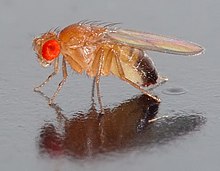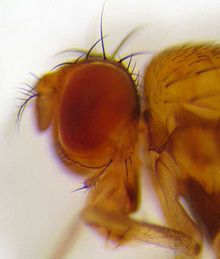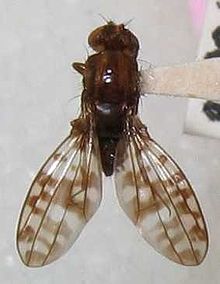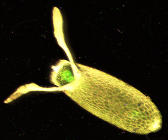| Revision as of 16:44, 14 March 2007 editApokryltaros (talk | contribs)Autopatrolled, Extended confirmed users, Pending changes reviewers, Rollbackers79,984 editsm rvt← Previous edit | Revision as of 21:32, 17 March 2007 edit undo82.13.28.6 (talk) →External linksNext edit → | ||
| Line 98: | Line 98: | ||
| * | * | ||
| * breeds hundreds of species and supplies them to researchers | * breeds hundreds of species and supplies them to researchers | ||
| * drosophila in captivity. | |||
| ==References== | ==References== | ||
Revision as of 21:32, 17 March 2007
| Drosophila | |
|---|---|

| |
| Drosophila melanogaster | |
| Scientific classification | |
| Kingdom: | Animalia |
| Phylum: | Arthropoda |
| Class: | Insecta |
| Order: | Diptera |
| Family: | Drosophilidae |
| Subfamily: | Drosophilinae |
| Genus: | Drosophila Fallén, 1823 |
| Type species | |
| Drosophila (Musca) funebris Fabricius, 1787 | |
Drosophila is a genus of small flies whose members are often called small fruit flies, or more appropriately vinegar flies, wine flies, pomace flies, grape flies, and picked fruit-flies. A second insect family, the Tephritidae are also called fruit flies; they feed on unripe or ripe fruit. One species in particular, Drosophila melanogaster, has been heavily used in research in genetics and is a common model organism in developmental biology. Indeed, the terms "fruit fly" and "Drosophila" are often used synonymously with D. melanogaster in modern biological literature. The entire genus, however, contains about 1,500 species and is very diverse in appearance, behavior, and breeding habitat.
Name
The term "Drosophila", meaning "dew-loving", is a modern scientific Latin adaptation from Greek words δρόσος, drósos, "dew", and φίλος, phílos, "loving" with the Latin feminine suffix -a.
Morphology


Drosophila are small flies, typically pale yellow to reddish brown to black, with red eyes. Many species, including the noted Hawaiian picture-wings, have distinct black patterns on the wings. The plumose (feathery) arista, bristling of the head and thorax, and wing venation are characters used to diagnose the family. Most are small, about 2-4 mm long, but some, especially many of the Hawaiian species, are larger than a house fly.
Life cycle and ecology
Habitat
Drosophila are found all around the world, with more species in the tropical regions. They can be found in deserts, tropical rainforest, cities, swamps, and alpine zones. Some northern species hibernate. Most species breed in various kinds of decaying plant and fungal material, including fruit, bark, slime fluxes, flowers, and mushrooms. A few species have switched to being parasites or predators. Many species can be attracted to baits of fermented bananas or mushrooms, but others are not attracted to any kind of baits. Males may congregate at patches of suitable breeding substrate to compete for the females, or form leks, conducting courtship in an area separate from breeding sites.
Several Drosophila species, including D. melanogaster, D. immigrans, and D. simulans, are closely associated with humans, and are often referred to as domestic species. These and other species (D. subobscura, Zaprionus indianus) have been accidentally introduced around the world by human activities such as fruit transports.
Reproduction



Males of this genus are known to have the longest sperm cells of any organism on Earth, including one species, Drosophila bifurca, that have sperm that are 6 cm long. The cells are mostly tail, and are delivered to the females in tangled coils. The other members of the genus Drosophila also make reletively few giant sperm cells, with D. bifurca's being the longest. D. melanogaster sperm cells are a more modest 2 mm long.
Drosophila vary widely in their reproductive capacity. Those such as D. melanogaster that breed in large, relatively rare resources have ovaries that mature 10-20 eggs at a time, so that they can be laid together on one site. Others that breed in more-abundant but less nutritious substrates, such as leaves, may only lay one egg per day. The eggs have one or more respiratory filaments near the anterior end; the tips of these extend above the surface and allow oxygen to reach the embryo. Larvae feed not on the vegetable matter itself but on the yeasts and microorganisms present on the decaying breeding substrate. Development time varies widely between species (between 7 and more than 60 days) and depends on the environmental factors such as temperature, breeding substrate, and crowding.
Laboratory–Cultured Animals

Drosophila melanogaster is a popular experimental animal because it is easily cultured in mass out of the wild, has a short generation time, and mutant animals are readily obtainable. In 1906 Thomas Hunt Morgan began his work on D. melanogaster and reported his first finding of a white (eyed) mutant in 1910 to the academic community. He was in search of a model organism to study genetic heredity and required a species that could randomly acquire genetic mutation that would visibly manifest as morphological changes in the adult animal. His work on Drosophila earned him the 1933 Nobel Prize in Medicine for identifying chromosomes as the vector of inheritance for genes.
However, some species of Drosophila are difficult to culture in the laboratory, often because they breed on a specific host in the wild. For some it can be done with particular recipes for rearing media, or by introducing chemicals such as sterols that are found in the natural host; for others it is (so far) impossible. In some cases, the larvae can develop on normal Drosophila lab medium but the female will not lay eggs; for these it is often simply a matter of putting in a small piece of the natural host to receive the eggs. The Drosophila Stock Center in Tucson maintains cultures of hundreds of species for researchers.
Predators
Drosophila are prey for many generalist predators such as robber flies. In Hawaii, the introduction of yellowjackets from the mainland United States has led to the decline of many of the large species. The larvae are preyed on by other fly larvae, staphylinid beetles, and ants.
Systematics
Currently, the genus Drosophila is highly paraphyletic (see below) and contains 1450 described species, while the estimated total number of species is at least 2000. The majority of the species are members of two subgenera: Drosophila (~1,100 species) and Sophophora (including D. (S.) melanogaster; ~330 species). The Hawaiian species of Drosophila (500+, with ~380 species described) are sometimes recognized as a separate genus or subgenus, Idiomyia (e.g.), but this is not widely accepted. About 250 species are part of the genus Scaptomyza, which arose from the Hawaiian Drosophila and later re-colonized continental areas.
Evidence from phylogenetic studies suggests that the following genera arose from within the genus Drosophila:
- Hirtodrosophila Duda, 1923
- Mycodrosophila Oldenburg, 1914
- Zaprionus Coquillett, 1901
- Samoaia Malloch, 1934
- Liodrosophila Duda, 1922
- Dichaetophora Duda, 1940
- Scaptomyza Hardy, 1849
Drosophila species genome project
Drosophila are extensively used as a model organism in genetics (including population genetics), cell-biology, biochemistry, and especially developmental biology. Therefore, extensive efforts are made to sequence drosphilid genomes. The genomes of the following species have been fully or partially sequenced so far:
- Drosophila (Sophophora) melanogaster
- Drosophila (Sophophora) simulans
- Drosophila (Sophophora) sechellia
- Drosophila (Sophophora) yakuba
- Drosophila (Sophophora) erecta
- Drosophila (Sophophora) ananassae
- Drosophila (Sophophora) pseudoobscura
- Drosophila (Sophophora) persimilis
- Drosophila (Sophophora) willistoni
- Drosophila (Drosophila) mojavensis
- Drosophila (Drosophila) virilis
- Drosophila (Drosophila) grimshawi
The data will be used for many purposes, including evolutionary genome comparisons. D. simulans and D. sechellia are sister species, and provide viable offspring when crossed, while D. melanogaster and D. simulans produce infertile hybrid offspring. The Drosophila genome is often compared with the genomes of more distantly related species such as the honeybee Apis mellifera or the mosquito Anopheles gambiae.
Curated data are available at FlyBase.
Trivia
Several of the subgeneric and generic names are based on anagrams of Drosophila. These include:
- Dorsilopha
- Lordiphosa
- Siphlodora
- Phloridosa
- Psilodorha
External links
- Fruit Flies in Space NASA-supported researchers are going to send fruit flies to the International Space Station to learn what space travel does to the genes of astronauts
- Fly Base FlyBase is a comprehensive database for information on the genetics and molecular biology of Drosophila. It includes data from the Drosophila Genome Projects and data curated from the literature.
- How to collect eggs from fruit flies
- Berkeley Drosophila Genome Project
- AAA: Assembly, Alignment and Annotation of 12 Drosophila species
- UCSC Genome browser
- TaxoDros: The database on Taxonomy of Drosophilidae
- Tucson Drosophila Stock Center breeds hundreds of species and supplies them to researchers
- Keeping and breeding drosophila in captivity.
References
- ^ Bächli, G. 1999-2006. TaxoDros: The database on Taxonomy of Drosophilidae.
- Markow, T. A. and P. M. O'Grady (2006). Drosophila: A guide to species identification and use. London, UK, Elsevier Inc.
| Major model organisms in genetics | |
|---|---|